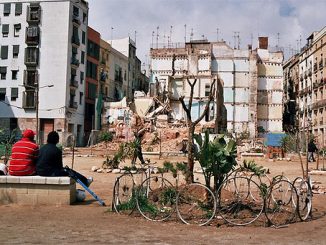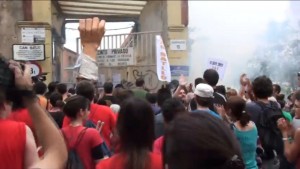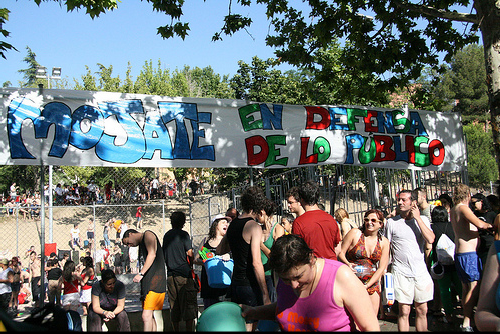
fiesta


On the occasion of the election of a new pope…
The speech of the great Manuela Trasobares [more about her] during the protest against the visit of Joseph Ratzinger to Barcelona, on november 7th, 2010, in a video made by our friend Jordi Secall: a political line about the church, the state, history… that reminds us of when, in Barcelona, we had a very clear opinion about these things. [original video in jordi secall’s blog :: reduced version in youtube, subtitled in SPANISH, ENGLISH & ITALIAN!]…

Where the salt water meets the fresh: les Saintes Maries de la Mer
More on popular celebrations: in may, in the village of french midi les Saintes-Maries-de-la-Mer (Camargue), an extraordinary strange celebration takes place, and gypsies have an important part in it. Together with the procession for the two “canonical” saints, Saint Salomé and Saint Jacobé, gypsies from all France and other parts of Europe gather for the procession of Santa Sara, Sara Kali, or Sara the black: who officially is only the servant to the other two saints, but that the gypsies promoted as their patron saint, and that they carry into the sea. This celebration was invented in the end of the XIX century to promote turism and save a depressed region from the effects of massive migration; today it is a strange festival “in disguise”, during which both gypsies, turists and camarguaises fully entered some kind of role play, with neither shame nor complexes. For three days, gypsies with high-class caravans draw their alliances and organize marriages, and settle just opposite to the folkloric carriages that the locals organize for turists. Everybody adopts for three days the identity that the others project on them, as they are all playing, just for partying, for singing and dancing regardless of their traditions and their original musical styles. Flamenco mixes with other musics, as the gypsies with non-gypsies, just like the fresh waters of river Rhone meet the salt water of the sea, and aigues mortes of Camargue melt into the live waters of the Mediterranean.
- Marc Bordigoni (2002-3), “Le ‘pèlerinage des gitans’, entre foi, tradition et tourisme” Ethnologie française, 2002/3, vol.32, pp. 489-501.
- Among the most assiduous invitees of Santa Sara’s celebration there is the romanés band Urs Karpats, here live in 2010, known also as Ursarii, or bear tamers
- Great video about the celebration and Santa Sara, with music by Urs Karpaz: TSIGHINDIA SARA KALI :: see also Kali Sara by Latcho Drom
- Sara Kali, i.e. Sarah the Black, is not recognized as saint by any official church; the fact that her statue wears clothes is a sign of popular religion – it is the devotion of the gypsies with canonizes her as holy. Actually her statue wears many dresses one upon the other, as to symbolize the extreme devotion of her devotees. Many connect her faith with indian goddess Kali, that is also dumped underwater in an annual celebration under the form of Durga.
[audio: https://periferiesurbanes.org/wp-content/uploads/2013/01/6Rumba-gitana.mp3] Rumba gitana in Santes Maries de la Mer, recorded by ethnomusicologist Roberto Leydi in 1968…

Recipes for interculturality from Bilbao
 Arroces del Mundo, Munduko Arrozak, is a popular fiesta being held since 2004 in San Francisco neighborhood, Bilbao (Basque country) . This barrio, apart from the center for the estuary and the railway, is four times more populated than the rest of the city; it has always been stigmatized as a ghetto, related with prostitution, considered a marginal part of the city where the immigrant live, and recently is becoming to be partially gentrified. The fiesta is the result of a patient networking that the Coordinadora de Grupos de Bilbao la Vieja, San Fraencisco y Zabala had been doing for years: this organization was born to influence in the Renewal Plan designed by the City Council, and is made of groups and individuals who had already done projects of social communication in the neighborhood. The idea of the fiesta serves both to denounce the abandon of the neighborhood, and to aim at the construction of intercultural relationships through autonomy and self-organization: the organizers of the event stress that as many people are involved, as less conflicts and incidents ocurr - with the practice, this undermines the securitarian discourse used by the authorities to increase police presence in San Francisco neighborhood.
Arroces del Mundo, Munduko Arrozak, is a popular fiesta being held since 2004 in San Francisco neighborhood, Bilbao (Basque country) . This barrio, apart from the center for the estuary and the railway, is four times more populated than the rest of the city; it has always been stigmatized as a ghetto, related with prostitution, considered a marginal part of the city where the immigrant live, and recently is becoming to be partially gentrified. The fiesta is the result of a patient networking that the Coordinadora de Grupos de Bilbao la Vieja, San Fraencisco y Zabala had been doing for years: this organization was born to influence in the Renewal Plan designed by the City Council, and is made of groups and individuals who had already done projects of social communication in the neighborhood. The idea of the fiesta serves both to denounce the abandon of the neighborhood, and to aim at the construction of intercultural relationships through autonomy and self-organization: the organizers of the event stress that as many people are involved, as less conflicts and incidents ocurr - with the practice, this undermines the securitarian discourse used by the authorities to increase police presence in San Francisco neighborhood. 
What can we do with industrial heritage? action and reflection from Barcelona’s Can Batlló
 In spite of all the scholarly studies on the importance of preserving Barcelona's ancient factories (Tatjer 2008), the usual practice in postindustrial urbanism has been their systematic demolition; sometimes preserving isolated chimneys: more than industrial memory, they seem to celebrate the annihilation of the worker's movement. The conflict around the industrial complex of Can Batlló, a 13 ha. late-XIX-century factory in La Bordeta district (Sants, Barcelona), almost completely abandoned, opposed (as usual) on one side the greed of the landowners and the complicity of the City Council, and on the other the needs and demands of the district's residents.
In spite of all the scholarly studies on the importance of preserving Barcelona's ancient factories (Tatjer 2008), the usual practice in postindustrial urbanism has been their systematic demolition; sometimes preserving isolated chimneys: more than industrial memory, they seem to celebrate the annihilation of the worker's movement. The conflict around the industrial complex of Can Batlló, a 13 ha. late-XIX-century factory in La Bordeta district (Sants, Barcelona), almost completely abandoned, opposed (as usual) on one side the greed of the landowners and the complicity of the City Council, and on the other the needs and demands of the district's residents. 
A naval battle in Vallecas (Madrid): utopia as a device to build identity
 2011 will be the 30th year in which, in the outskirts of Madrid, and despite the ban of the City Council, the Naval Battle of Vallekas will take place: a popular and politically engaged fiesta that celebrates the independence of the neighborhood and its the proclamation of Vallecas as a seaport. Anthropologist Elizabeth Lorenzi, got involved in the neighborhood since 1998, and recently published an ehtnography of the fiesta (downloadable for free in PDF) in which, beginning from the Naval Battle, she analizes the urban and social transformations of Vallecas in the last decades, the role played in it by the grassroot movements, and the consequences of all this in the building and maintanance of the neighborhood identity. The Naval Battle celebrates and strenghtens the vallekanismo: the neighborhood as a frame for social mobilizations. Through this symbolic device, the long history of political demands, neighbors' struggles, anarchist movements of Vallecas, become part of the process of constructing the neighborhood identity.
2011 will be the 30th year in which, in the outskirts of Madrid, and despite the ban of the City Council, the Naval Battle of Vallekas will take place: a popular and politically engaged fiesta that celebrates the independence of the neighborhood and its the proclamation of Vallecas as a seaport. Anthropologist Elizabeth Lorenzi, got involved in the neighborhood since 1998, and recently published an ehtnography of the fiesta (downloadable for free in PDF) in which, beginning from the Naval Battle, she analizes the urban and social transformations of Vallecas in the last decades, the role played in it by the grassroot movements, and the consequences of all this in the building and maintanance of the neighborhood identity. The Naval Battle celebrates and strenghtens the vallekanismo: the neighborhood as a frame for social mobilizations. Through this symbolic device, the long history of political demands, neighbors' struggles, anarchist movements of Vallecas, become part of the process of constructing the neighborhood identity.